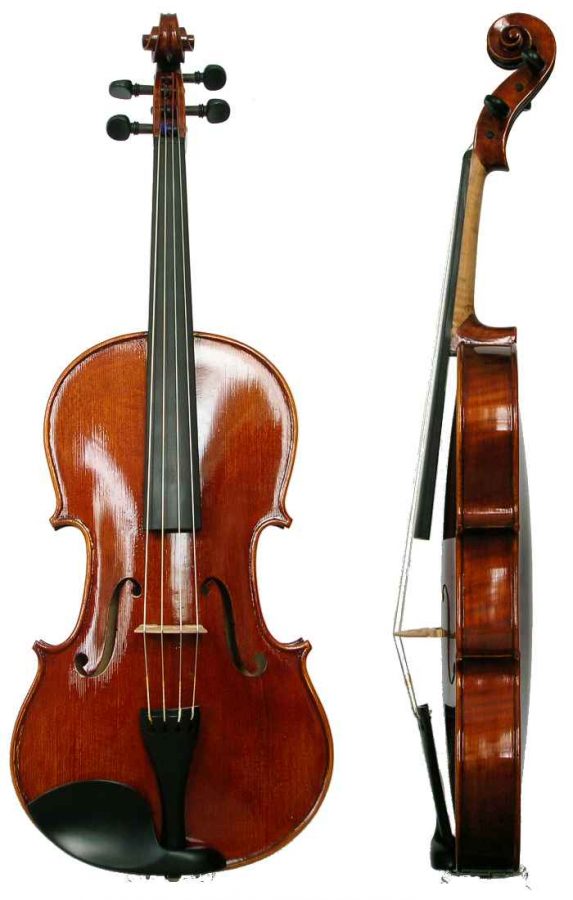Whenever I ask someone if they know what a viola is, they often end up guessing, “It’s something like a violin, right?” However, if the person in question does in fact know what a viola is, they begin to make fun of it. What is this instrument and why does it have such a bad reputation?
The viola is a musical instrument, and is a part of the string family. It is played like the violin – resting under the chin of the musician, and it requires a bow. The word “violin” was actually derived from the word “viola,” according to the Vienna Symphonic Library. Even though a viola may look similar to a violin, they are most definitely not the same thing.
According to Britannica, the viola and the violin have three main distinct differences. First of all, the strings of the viola are C, G, D and A, while the strings of the violin are G, D, A and E. The C string on the viola allows the instrument to have a lower pitch range, while the E string on the violin allows the instrument to have a higher pitch range.
Due to this difference in pitch, the viola and the violin read in different clefs. The violin reads in the treble clef, and the viola reads in the alto clef. In addition, in order to allow for a more resonant sound for the lower pitches, the viola is proportionally larger than the violin and can be up to 4 inches longer.
Violas are used in ensembles and string quartets. Some of the most famous pieces from the viola repertoire are “Romeo And Juliet” by Sergei Prokofiev, “Op. 25 No. 1” by Paul Hindemith and the Viola Concerto by Béla Bartok.
The viola has a unique and beautiful tone. According to Britannica, “The viola’s tone is darker, weightier, and warmer than that of the violin.” As Andrea Whitt, a touring violist, artist, and Harvard Westlake (HW) viola coach, puts it, “[The viola] has such a beautiful tamber, and it’s more of the range of the human voice. It can really resonate with people.”
However, many musicians tend to make fun of violists, so much so that there are even jokes referred to as “viola jokes.” Carl Rahkonen, a violist, Music Librarian and Professor at Indiana University of Pennsylvania, said, “Viola jokes are typically jokes of disparagement, similar in structure and content to ethnical, political, ‘dumb blond’… or lawyer jokes.”
According to WQXR, an American classical music radio station, Viola jokes originated in the 1700s, when the viola was just being created. The viola did not have a definite shape, and was transitioning from being played like a cello, to being played like a violin. Some claimed that violists appeared somewhat “awkward,” when in fact that was just because of the shape of their instruments. Nowadays, jokes about the viola are actually about the violists themselves. Rahkonen said, “Viola jokes mock (perceived) musical incompetence.”
However, making fun of the viola has not always been the norm. According to the Vienna Symphonic Library, during the 16th and 17th centuries in France, it was common to see string ensembles with five parts. “The middle register was played by three violas in the same tuning but of various sizes (cinquième, haute-contre, taille),” according to the Library. During this time, violas were valued for providing a foundation. With the blooming baroque style in the 17th century, lighter tones were desired, and this is when the violin gained its popularity over the cello and viola.
Viola jokes are very stereotypical, but why are stereotypical jokes such a big problem? In order to understand this, it’s important to note why stereotypical jokes exist in the first place. According to Michigan Daily, Psychology Professor Lawrence Hirschfeld said, “Not only do people find it entertaining, but the exaggerated portrayals are also easy to understand and ‘catchy’.
Six studies done at University of Pennsylvania and University of California, Berkeley show some of the most common stereotypes that we make of other people is their “warmth and competence.” These two characteristics can allow us to gauge how approachable other people can be. This same logic can be applied to choosing an instrument to play. If others are constantly making fun of violists, less and less people will be inclined to play the viola, as they have been taught to agree with the stereotypical assumptions made by others. If this pattern continues, over time it will be very detrimental in terms of finding young people to learn the viola.
Nonetheless, these stereotypical jokes aren’t enough to stop people from playing the instrument that they love. According to the Los Angeles Times, when asked how he responded to encountering viola jokes, Ronald Kato, the principal violist with the Los Angeles Chamber Orchestra said, “Playing well is the best revenge.” This type of mindset can encourage young violists to defy the stereotypes laid out by our modern society.
According to the Washburn Center for Children, “If a child tries to change [their] personality in order to fit in, [they] may struggle with [their] identity.” The viola can serve as an outlet for children of any ages, and a way to improve self-esteem and confidence for standing out. Some students are drawn to the viola partly because it’s so unique. This was the case for Whitt. “I think I was just drawn to it because it has this lower tamber to it, and it was a little different,” she says. “I didn’t want to be like everyone else.”
The viola is not a “big violin” or a “tiny cello”. Not only does the viola’s dark yet warm tone open doors for awesome music, but playing the viola is also a wonderful way to build character, musicality, strength and confidence.











